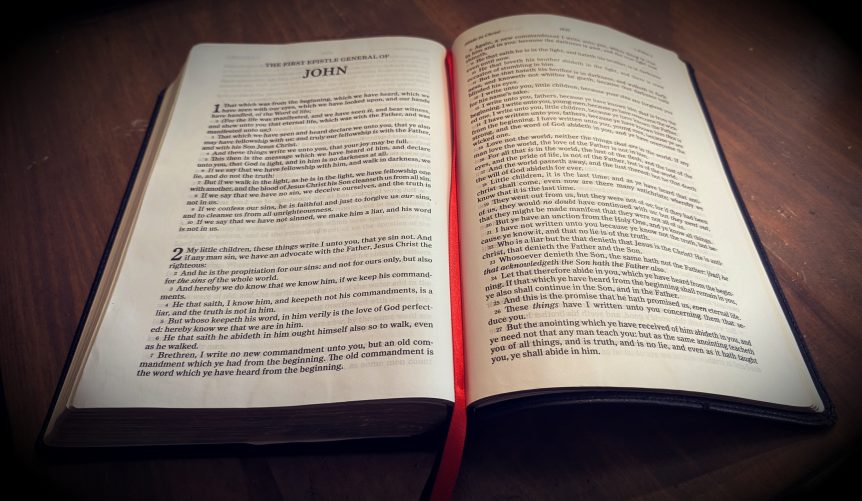Epistles of John
Pastor Gabriel Render 1/14/25
The Letters of John contain many well-known verses. Most anyone can cite that “God is love”, and many recall a verse about “walking in the light” or perhaps overcoming the world because “greater is he that is in you than he that is in the world.” But many Christians have not taken the time to truly delve into the depth of this seemingly straightforward pastoral letter.
John, unlike many of the other Epistles, structures his letter in more of a sermon format, and takes on a very fatherly tone with his recipients. This, however, does not mean that this letter is devoid of rich doctrine, or other theological treasures. Right out the gate he reminds believers of the foundation of their fellowship with God and one another, namely being recipients of the historic Gospel handed down by the account and teaching of the Apostles. Further, he immediately makes one of his chief goals known– confronting gnostic heresy. Right at the outset he lays out the eternality and humanity of Christ, affirming the doctrine of the hypostatic union (as we have come to call it, that is Christ as both truly God and truly man).
One of the earliest heresies the Apostles had to deal with was the gnostic heresy in its various forms. Gnostic, from the Greek gnosis meaning knowledge, referred to various heresies that required secret knowledge beyond the Gospel and Apostolic teaching and usually centered on various denials of Christ’s humanity. The gnostics generally believed matter to be inherently evil (despite the clear declaration of it being good in Genesis) and believed Spirit to be the higher good of which all must pursue. As such they denied that Christ had a true human nature.
John in particular was dealing with the docetists and Cerinthian gnostics. The docetic heresy teaches that Jesus Christ did not have a physical body. The word “docetic” comes from the Greek word dokein, which means “to seem.” As such they believed Christ merely had the appearance of a physical body. This obviously has immense consequences for the Gospel and Christ as a genuine substitute and had to be thoroughly refuted.
“As soon as ever God the Holy Ghost begins to work upon the soul of man to illuminate him, he perceives at once his own sinfulness, he abhors that sinfulness, he labours to escape from it, he cries out for a remedy, he finds it in Christ; henceforth he no longer loves sin, he is not guided any longer by the darkness of policy, and selfishness and error, but he walks after the light of the truth of God, of righteousness, of holiness, of true knowledge. God has brought him into light: he sees now what he never saw before; knows, feels, believes, recognises what he never had known anything of aforetime— he is in the light. Hence you constantly find the Christian called a child of light, and he is warned that he is of the light and of the day. He is told, “Ye are not of the night nor of darkness.” “Ye were sometime darkness, but now are ye light in the Lord: walk as children of light.” –Charles Haddon Spurgeon
Cerinthius on the other hand, taught that angels created the world, that Jesus was the biological son of Mary and Joseph, and that he became divine upon his baptism. He also believed that the divine “Christ” left Jesus before the crucifixion and resurrection. As such he managed to deny both portions of Christ’s humanity and divinity. If it hasn’t occurred to you yet, yes, many modern-day cools still continue variations of these heresies (who’s looking at you LDS and JWs).
John, very fatherly in his pastoral exhortations, seeks to right these wrongs and does so very plainly and clearly. He writes in 1 John 4:2 “Hereby know ye the Spirit of God: Every spirit that confesseth that Jesus Christ is come in the flesh is of God.” He demands the proper view of Christ’s humanity as a necessary reality and truth essential to the Gospel.
Beyond his refutation of heresy, this letter seeks to clearly define what it means to live like a Christian in true fellowship with God. He does this by making two primary analogies with application- that God is light, and that God is love. He then describes how the Christian ought to live as a result of these glorious truths. This letter, like James’ epistle, seeks to thoroughly remind the reader that the Christian cannot be so in name only. The true follower of Christ obeys the commands of Christ and lives a changed life of joyful commitment to God, his word, and his ways.
I look forward to working through this letter and the two brief following letters in the coming months.
While the first is a short letter, only five chapters, it is one that should not be rushed through.
-Grace and Peace-
1 John Structure
1st John is unlike Paul’s letters in that it is more of a sermon, following themes and analogies in a cyclical argument rather than a letter building a systematic argument (Paul typically argues in logical flow, stating this is who God is and what he has done, therefore live in this way in response).
Chapters one through three focus on the first major analogy- God is light.
Chapters 3 through 5 focus on the second major analogy- God is love.
John states these premises, applies them, and then comes back and restates them in a different way with further application.
This process of cyclical argument and repetition serves to drive home the importance of his exhortation.
Questions For Consideration:
- What does it mean to be genuinely converted?
- What is the gospel and who is it for?
- What is the fruit of the gospel?
- Main introductory theme: What is the basis for fellowship w/ God and by consequence w/ one another?

